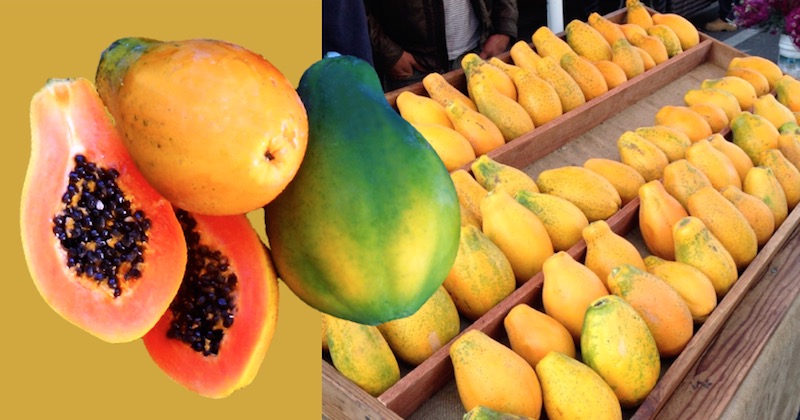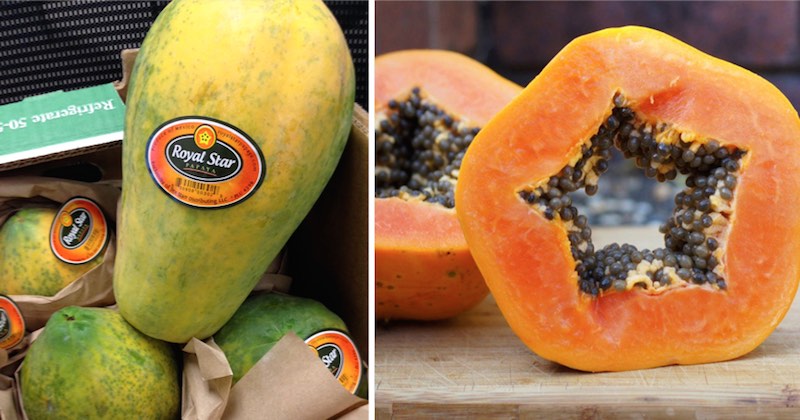Tips On How To Choose A Papaya That Is Non-GMO
Last updated on
You may have read over and over again, how good papayas are, and how they can be added to your anti-cancer diet. Yet, many people in America are avoiding papaya because papayas are one of the most common GMO crops!
There are so many reasons why you should eat the papaya fruit, papaya leaves and papaya seeds.
What is GMO?
GMO means “genetically modified organism“; crops or animals that are produced in a lab by extracting the genes of one specie and artificially forced into the genes of an unrelated plant or animal. This genetic engineering modification is done to obtain a desired trait or characteristic.
The organism extracted may be a bacterium or virus that is used to “infect” the plant or animal cells. The end-result creates “transgenic organisms”. This means that it is a newly created organism that is unnatural, unstable and against natural or traditional crossbreeding methods.
Why Are Genetically Modified Crops Potentially Dangerous?
Traditional plant breeders work with plants of the same or related species to create new plant varieties. But genetic engineers use bacteria, viruses to create something that may have unforeseen consequences.
The process of inserting genes into the DNA of a food plant is random and scientists have no idea where the genes go. This can disrupt the functioning of other genes and create novel and unnatural proteins that could create toxins and allergens in foods.
What Are Some Genetically Modified Crops?
Some of the crops currently approved to genetic modification in the US, are corn, soybeans, cotton, canola, sugar beets, alfalfa, papaya and zucchini.
Papayas Are Genetically Modified?
Although a majority of papayas in the US are genetically modified, you don’t have to avoid them. Learn these tips on how to look for non-GMO papayas. They are so rich in nutrients and a superb anti-cancer food.
Of the 30 million pounds of papaya produced in the US, 75 percent are GMO papayas from Hawaii. But wait! Don’t give up yet on papayas. There are still non-GMO papayas out there, you just need to know what to look for.
How To Choose A Non-GMO Papaya
1. Buy Certified Organic Papayas
Organic papayas may be hard to find, but when you chance upon any, grab them! Certified organic papayas are definitely non-GMO and the best choice as there are no pesticide residues. These PLU codes labeling might give you some clues!
2. Check The Source Of The Papayas
Avoid papayas that are from Hawaii as a majority of them are genetically modified. The only papayas from Hawaii that are not GM are their original, native papayas. So, if you’re in Hawaii, look for the Kapoho variety. They have a yellowish flesh, not pink like most GMO papayas.
Look for papayas that are grown in Asia, Mexico, Brazil or Belize. Ask your grocery store. Papayas grow in abundance in these countries, and the good news is that genetic engineering are not practiced there.
Look Out For These Papaya Varieties
GMO Papayas—Avoid!
In the early 1990s, Hawaii’s papaya industry was attacked by the deadly papaya ringspot virus (PRSV). In order to “save” the papaya plantation, a breed was genetically engineered to be resistant to the virus.

The other GM papayas to be avoided are the SunUp and Rainbow varieties. They look very much like the Strawberry Papaya as shown in the image above.
Sunup = Sunset + gene PRSV virus
Rainbow = SunUp + Kapoho (the original native papaya)
Non-GMO Papayas
These papaya varieties are not from Hawaii, so are not genetically modified.
The Maradol Papaya forms about 95% of the papaya production from Mexico. The Maradol papayas from Belize are marketed under the names of Caribbean Sunrise or Caribbean Red. Unlike the Hawaiian papayas, this variety is elongated and cylindrical, measuring about 8 to 11 inches and weighs about 3 to 7 pounds.


Related reading:
How to eat papaya seeds to detoxify liver, kidneys and heal the digestive tract
How to drink papaya leaf juice to increase blood platelets
How to include every part of this superfood papaya in an anti-cancer diet
More amazing reasons why you should eat papaya
References:
https://www.nytimes.com/2014/01/05/us/on-hawaii-a-lonely-quest-for-facts-about-gmos.html
https://en.wikipedia.org/wiki/Genetically_modified_food
Some of the links I post on this site are affiliate links. If you go through them to make a purchase, I will earn a small commission (at no additional cost to you). However, note that I’m recommending these products because of their quality and that I have good experience using them, not because of the commission to be made.

































 JOIN OVER
JOIN OVER
Comments